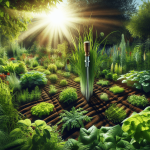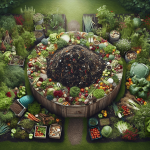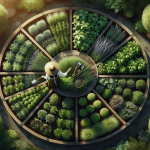This post may contain affiliate links. As an Amazon Associate, we may earn commissions from qualifying purchases.
Have you ever found yourself worrying about keeping a steady supply of leafy greens throughout all four seasons? Whether you’re nurturing an urban balcony garden or tending to a countryside greenhouse, growing your own leafy greens year-round is both rewarding and sustainable. Let’s uncover the practices that transform you from a seasonal gardener to a year-long leafy green aficionado.
Planting and caring for your own greens not only brighten up your meals but also provide a handy response to that eternal question, “Is it fresh?” Instead of relying on store-bought varieties that have traveled untold miles and spent time on uncertain shelves, growing your own can be a game-changer. But how can you be certain those robust leaves, vibrant and rich with nutrients, are cropping up in any season?
Understanding Leafy Greens
Leafy greens come in many shapes, sizes, and flavors. From the crispy crunch of lettuce to the peppery zest of arugula, these plants are a staple in sustainable eating. Understanding the different varieties is pivotal for anyone aiming to cultivate them all year long.
Types of Leafy Greens
Here’s a rundown of common leafy greens to consider for your garden and their unique characteristics:
| Leafy Green | Characteristics | Preferred Growing Conditions |
|---|---|---|
| Lettuce | Soft, buttery texture; includes varieties like Romaine and Iceberg | Cool temperatures, ample sunlight |
| Spinach | Rich iron content, mild taste | Cold-tolerant, partial shade |
| Arugula | Peppery flavor, grows quickly | Cool climate, well-drained soil |
| Kale | Hardy, curly leaves with a robust flavor | Cool seasons, tolerates frost |
| Swiss Chard | Bright, colorful stalks; slightly bitter taste | Tolerates heat, needs full sun |
Labeling your greens can simplify the planting task—they’re not all the same, but don’t tell them that; it might go to their heads.
Essential Tools and Equipment
Before jumping into the garden with both hands, it’s best to prep your tool kit. It’s like packing for vacation; you don’t want to reach paradise to realize you’ve forgotten your toothbrush.
Basic Gardening Equipment
Here’s a handy checklist of essential tools you’ll need to work with your leafy characters:
| Equipment | Purpose |
|---|---|
| Trowel | For planting seeds and moving your plants into slightly bigger pots as they grow. |
| Watering can | Delivers hydration without disturbing the soil (if you prefer): think spa, not typhoon. |
| Pruning shears | Keeps plants in shape and removes unhealthy leaves. An occasional haircut revitalizes, even for greens. |
| Gloves | Protects your hands from thorns, blisters, and maybe even a muddy fashion faux pas. |
| Fertilizer | Ensures your leafy greens have enough nutrients to prosper. Make sure it’s balanced for leafy greens requirements. |
Having these ready will make you feel like the seasoned gardener you aim to become, sans the mud-spattered overalls.

Planning Your Year-round Garden
Timing, soil, and understanding environmental conditions play key roles in growing leafy greens. Much like an orchestra where timing, rhythm, and harmony produce an excellent symphony, your garden needs each element in sync to flourish beautifully.
Climate Considerations
In the realm of horticulture, climate is king—or queen if your greens are feminist. It’s satisfying to match the needs of your crops with the environment they’ll grow in.
-
Cool Climates: In cooler areas, or during winter months, using row covers or cold frames can offer your greens the protection they need, extending their growing season.
-
Warm Climates: For those in warmer climates, consider using shade cloths to protect young plants from extreme sun or employ succession planting, so there’s something new ready just as older plants fade. Don’t forget, greens like kale have a preference for cold weather and might become bitter in too much heat.
Soil Mastery
The backbone of your leafy endeavors is rooted in soil health—literally. Think of it as having a cup of coffee before tackling your day; it sets the pace for what follows.
- Soil Test: Assessing soil pH is essential for leafy greens. Most thrive in neutral to slightly acidic soil (pH 6.0 to 7.0).
- Composting: Introduce organic matter regularly to improve soil structure and nutrient availability. This can be kitchen scraps or more elaborate compost heaps for the ambitious.
- Drainage: Well-draining soil is crucial to prevent waterlogging, which leafy greens disdain.
Indoor vs. Outdoor Cultivation
The promise of year-round greens depends heavily on how you decide to nurture them.
- Indoor Cultivation: With the blessing of grow lights and controlled settings, practically anything can be coaxed into a perennial cycle. This is ideal for those with limited space but plenty of ambition.
- Outdoor Cultivation: Choosing the right season and employing protective measures against too much heat or cold are your tickets to success. Greenhouses can exponentially extend seasons and production volumes.
Best Planting Practices
Arming yourself with knowledge is the first step to leafy success. Timing and strategic planting not only increase yields but ensure your produce’s vibrancy and nutrition remain top-notch.
Succession Planting
Avoid putting all your green eggs in one basket. Succession planting involves sowing small batches at staggered intervals, ensuring a consistent harvest rather than feast-or-famine cycles.
- Try Planting Cycle A-b:
- Plant a small batch every two weeks.
- Alternate between varieties to keep the plate interesting, alternating between quick-growers like lettuce and slower ones like kale.
Companion Planting
Consider this the ultimate friends and frenemies list of your garden. Let’s match your greens with effective partnerships:
| Vegetable | Benefits |
|---|---|
| Radishes | Grow quick and loosen soil |
| Carrots | Share the space for mince use |
| Tomatoes | Provide shade, deter insects |
| Onions | Repel pests |
Companion planting not only utilizes shared spaces efficiently but also reduces pests, enhancing growth.

Nutrient Guidance for Leafy Greens
Your leafy beauties not only need love but nutrition too. Eating is an act of intimacy where the soil feeds your greens, which then nourish you.
Balanced Fertilization
Precise fertilizing is fundamental, and striking a balance can transform “what a nice garden” to “are you a professional?”
- Nitrogen: Crucial for lush, green foliage. Use compost tea or water-soluble options through the growing season.
- Potassium/Magnesium: Aids in disease resistance and overall plant health.
Be gentle; too much nutrition can have counterproductive effects like rapid, weak growth (think plant Superman on a sugar rush).
Watering Wisdom
Watering leafy greens is both an art and a science. Aim for consistency—much like how you crave stability between haphazard social adventures.
- Spring to Summer: Increase watering as plants grow and temperatures rise. Early mornings or late afternoons are best.
- Autumn to Winter: Reduce frequency, but don’t dry them out entirely. If indoors, monitor humidity levels.
Mulching is particularly helpful, locking in moisture and easing up on your watering duties.
Dealing with Pests and Diseases
Just when everything seems calm, the villains of the leafy green world appear: pests and diseases. It’s like the melodrama of a prime-time soap opera unfolding in your garden, day after day.
Pest Control
Garden pests are crafty, but your resolve can be craftier.
| Pest | Method of Control |
|---|---|
| Aphids | Blast water spray or use neem oil |
| Slugs/Snails | Use coffee grounds, eggshells, or copper wire for barriers |
| Cabbage Worms | Bacillus thuringiensis or hand-picking |
Consider companions as pest deterrents—marigolds and nasturtiums make fine allies against aphids and nematodes.
Disease Management
Some call it the C-minus of gardening, but dealing with disease is more manageable with keen vigilance.
- Crop Rotation: One season’s kale into another’s lettuce. This reduces disease carryover in the soil.
- Quarantine Newbies: New plants or seeds staying separate from your loyal stock can face less likelihood of catching rampant bugs.
- Fungicide: For fungal issues like powdery mildew, use sulphur-based or copper fungicides after reading appropriate usage labels.
Harvesting and Beyond
When greens are ripe for the picking, knowing when and how is just as valuable as how they got there. And in this realm, proper storage goes hand in hand with the joy of the harvest.
Optimal Harvesting Times
Cruise control the calendar and your moods; knowing when to harvest can secure your greens’ flavor and longevity.
- Morning Harvest: For crispness that’s tough to beat while maintaining the dewy freshness from overnight.
- Leaf Check: Harvest when leaves are firm and vibrant, making sure to frequently snip to encourage regrowth.
Post-Harvest Storage
Storing your treasured greens is akin to allowing them to rest up before the show-stopping dinner party.
- Refrigerate promptly in breathable bags: Tossing them in plastic could be akin to imprisonment, but too much freedom and they may dry out.
- Avoid Washing Pre-storage: Quick rinse only before use prevents early spoilage.
Harness these techniques, and you’ll have not just a garden but a balm for stressful modern life—you’ll eat better, feel grounded, and create a little slice of leafy Eden all your own.
May your garden grow bountiful, and your salads never run dry. With these guidelines and a sprinkle of humor to light the path, your journey into year-round leafy green gardening will surely flourish into an enriching and perhaps green-thumbed legacy.








